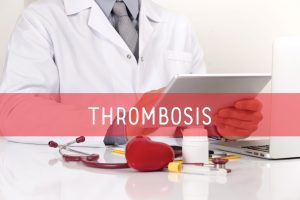In this guide, we discuss how to claim compensation for a misdiagnosed blood clot. Doctors and other healthcare professionals are trained to spot the symptoms of blood clots. However, acts of negligence do occur, and if clots in blood vessels are misdiagnosed as muscle strains or cramps, patients could be left with profound harm. In some instances, the impact can be fatal.
Deep vein thrombosis (DVT) is a blood clot that develops in a vein, usually a leg. Each year, DVT affects around 1 person in every 1000 in the UK. It is estimated that 25,000 people die every year from preventable blood clots in the vein
To find out if you could make a blood clot compensation claim for yourself or another person, please contact our team.
- Talk to us about your clinical negligence case by calling 0800 073 8801.
- Start a claim online using our form.
- Chat to us using the live support feature.
Jump To A Section
- Can I Claim For A Misdiagnosed Blood Clot?
- How Can A Blood Clot Be Misdiagnosed?
- How Much Compensation For Misdiagnosis Of A Blood Clot?
- What Is The Time Limit When Claiming For Medical Negligence?
- What Evidence Could Help Me Prove A Misdiagnosed Blood Clot?
- Claim For The Misdiagnosis Of A Blood Clot On A No Win No Fee Basis
- More Resources About Medical Misdiagnosis Claims
Can I Claim For A Misdiagnosed Blood Clot?
A blood clot (of a Thrombus) is a gel-like mass. They can form in the veins or arteries. When a blood vessel is damaged platelets release molecules to form a plug. This gradually grows into a clot. Normally other protein factors should stop it growing too much and break it down. You can read more about blood clots in this NHS resource.
Whilst you are under the care of a medical professional you are owed a duty of care by them. They must ensure that the care they provide to you meets the minimum expected standard, such as meeting professional standards.
Medical professionals should take steps such as;
- Providing you with the correct medical advice.
- Listening to your symptoms and concerns and taking these seriously. In this instance symptoms may include throbbing, swelling, redness and warmth among others.
- Referring you for further tests or specialist care where appropriate.
For you to make a claim for a misdiagnosed blood clot you need to show that:
- A medical professional owed you a duty of care.
- That they breached their duty of care to you.
- That this breach caused you to suffer avoidable harm.
What Harm Could A Blood Clot Misdiagnosis Lead To?
If a blood clot or DVT is not diagnosed and treated early patients could be left with serious complications and even life-changing harm. Blood clots could cause potentially life-threatening conditions such as;
- A pulmonary embolism caused by clots blocking a blood vessel in the lungs.
- Strokes if the blood clot travels to an artery in the brain.
- Heart attacks if the arteries of the heart are affected.
- Mesenteric ischemia. This is where a blood clot forms in intestinal arteries.
If NHS negligence has caused the misdiagnosis of a blood clot, please call us for further advice.
How Can A Blood Clot Be Misdiagnosed?
A misdiagnosed blood clot or DVT could occur due to a doctor misinterpreting a patient’s symptoms. The symptoms of a DVT or blood clot may also present in a variety of other conditions ranging from muscle strains to cramps or sciatica.
It is important that healthcare professionals consider blood clots when making a diagnosis involving these symptoms. NICE, The National Institute of Health and Care Excellence publishes guidelines on deep vein thrombosis diagnosis.
According to the NHS, if any healthcare professional suspects you have a condition such as a DVT, you should be referred to a hospital. There an ultrasound scan should be carried out to detect the clot. The hospital may also perform an x-ray of the vein. This is called a venogram and a dye will be injected to highlight the location of any clots.
This referral should happen within 24 hours. The failure to refer a patient for a suspected clot in a blood vessel could be classed as clinical negligence and could lead to a misdiagnosis claim.
DVT or blood clot misdiagnosis could include:
- Misdiagnosing a blood clot or a DVT as another condition.
- Failing to refer a patient for tests (such as an ultrasound or x-ray).
It should be noted that if the medical professional did act in a way that other medical professionals would have done, you may not be able to make a misdiagnosis compensation claim.
How Much Compensation For Misdiagnosis Of A Blood Clot?
How much compensation for misdiagnosed blood clots may be awarded is a frequently asked question. Compensation for a misdiagnosed blood clot is designed to compensate people for their pain and suffering as well as additional impacts that they have experienced. Blood clot compensation settlements may be made up of two parts. These are special damages (covering financial and other impacts) and general damages (covering pain and suffering).
A medical negligence solicitor or other parties in a claim may use guidelines published by the Judicial College (JC) to work out how much may be awarded for general damages. In our table below we take examples from the JC. Please be aware that the figure in the first row is not from the JC. It is an example of what could be awarded for a combination of multiple serious injuries and special damages.
| Type Of Harm | Severity | Compensation |
|---|---|---|
| Multiple and serious forms of harm with special damages. | Serious to severe | Up to £1,000,000+ inclusive of special damages. |
| Brain/ head | A - very severe | £344,150 to £493,000 |
| Brain/ head | B - moderately severe | £267,340 to £344,150 |
| Brain/ head | C - moderate - i | £183,190 to £267,340 |
| Brain/ head | C - moderate - ii | £110,720 to £183,190 |
| Brain/ head | C - moderate - iii | £52,550 to £110,720 |
| Brain/ head | D - less severe | £18,700 to £52,550 |
| Kidney | A - serious damage to both kidneys or the loss of. | £206,730 to £256,780 |
| Lung disease | A - a young person who suffers a serious disability and could die prematurely. | £122,850 to £165,860 |
| Lung disease | D - breathing difficulties which are short of being disabling. | £38,210 to £66,920 |
Special damages may be awarded to compensate you for costs and losses including:
- Lost income and earnings.
- Care related costs.
- Medical expenses.
- Medication costs.
- Adapting a home.
Whether you sue the NHS for misdiagnosis or claim against a private services provider our team could help you. Contact us today.
What Is The Time Limit When Claiming For Medical Negligence?
In line with The Limitation Act 1980, if you are claiming compensation for blood clots you (generally) have three years in which to start the claims process.
For this reason, it’s important to submit your claim in a timely manner.
There are exceptions to this time limit where you may be able to claim beyond the general three year limitation period. These are;
- Where the claimant lacks the mental capacity to make a claim on their own behalf, the time limit will be frozen indefinitely. The time limit will not be reinstated unless they regain the capacity to make a claim. If they do regain their capacity to claim the time limit will begin on their recovery date.
- Where the claimant is under the age of eighteen. The time limit will be suspended until their eighteenth birthday. They will then have between their eighteenth and twenty first birthdays.
In these cases when the time limit is suspended and the claimant is unable to claim for themselves, a Litigation Friend may be appointed by the court to act on their behalf.
Learn more about how long you may have to make a misdiagnosis compensation claim by speaking to a member of our team.
What Evidence Could Help Me Prove A Misdiagnosed Blood Clot?
In order to claim for a misdiagnosed blood clot, you will need to provide evidence to show how a healthcare professional has acted negligently. This may be evidence which shows that a GP did not refer you to a hospital for further testing, that tests were carried out negligently or that a medical professional otherwise breached their duty of care to you.
Types of evidence which could help to prove the misdiagnosis of a blood clot may include:
- Copies of your medical records,
- Contact details from anyone who attended appointments with you so a witness statement can be taken later on,
- Photographs of any visible injuries, such as the redness and swelling of your skin,
- Records of any financial costs or expenses,
As part of the medical negligence claims process you may be invited to an independent medical assessment where a report will be made that can be used when it comes to valuing the harm you have suffered. As well as this, a Bolam test may be carried out. This is where a panel of similarly trained medical professionals review whether the care you received was of that of a competent practitioner. The findings of this will be used as evidence in your case.
For more information on how to prove medical negligence and what evidence may support your claim, please contact our team.
Claim For The Misdiagnosis Of A Blood Clot On A No Win No Fee Basis
You can find out if you are eligible to make a claim for a misdiagnosed blood clot by contacting our team. Our team could help you to make a complaint about misdiagnosis, provide advice on the types of evidence which could support a claim and could help to assess whether you have grounds to claim for the misdiagnosis of a blood clot.
Our team is on hand 24 hours a day, 7 days a week. If they think you are eligible to claim, they could connect you to a No Win No Fee solicitor. A solicitor could help you through a Conditional Fee Agreement. This is a type of agreement under which a solicitor can provide their services. There are no upfront fees for your solicitor’s work.
If you win your claim, your solicitor will deduct a success fee. This is calculated as a set percentage of your settlement. The percentage is legally limited, so you will keep the majority of your compensation.
To find out how to make a claim for a misdiagnosed blood clot, please contact our team. You can get a free consultation by using the following contact methods;
- Call a member of our team on 0800 073 8801.
- Use our online form to start a claim.
- Use our live support feature.
More Resources About Medical Misdiagnosis Claims
Here, we have included further examples of resources from our site.
- If you have been harmed by x-ray negligence, you can learn more about making claims here.
- In this guide, we look at how to make birth injury claims.
- Here, you can learn more about how to claim negligent blood test compensation.
Below, you can learn more:
Learn more about Good Medical Practice in this guide from the General Medical Council.
Read about Statutory Sick Pay in this government guide.
This British Heart Foundation resource contains more information on deep vein thrombosis.
Thank you for reading our guide to claiming for a misdiagnosed blood clot. For more information, please contact us.







